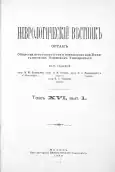Effect of botulinum toxin on lower vertebrates in connection with changes in the nervous system of them
- Authors: Favorsky A.1
-
Affiliations:
- Institut of Pasteur
- Issue: Vol XVI, No 1 (1909)
- Pages: 93-113
- Section: Articles
- URL: https://journals.rcsi.science/1027-4898/article/view/62556
- DOI: https://doi.org/10.17816/nb62556
- ID: 62556
Cite item
Full Text
Abstract
In 1897, V. Ermengem established that the well-known phenomena of botulism in the clinic owe their origin to a special pathogenic saprophytic bacillus discovered by him, bacillus botulinus. He stated that the pathogenic action of this bacillus depends on that toxic principle, which lies in its protoplasm and those environments, strictly anaerobic, where it is able to develop. Introducing the culture of this bacillus or its pure toxin into the animals' mouth or under the skin, he became convinced that some of them are very sensitive to this poison, others are less susceptible and, finally, others are completely immune. The first to include rabbits, mice, guinea pigs, monkeys, which died with typical phenomena of botulism from the minimum doses. The second group includes cats, pigeons, and rats, which perished from more high doses; to the third, he classifies dogs, hens and,. mainly frogs, fish, cyprinus, which, according to him, have complete immunity. However, establishing the fact that animals are different in relation to the pure toxin bac. botulinus, V. Ermengem often does not provide definite data on the lethal minimum dose of the toxin for these animals. There is an exact indication of the dose of the toxin only for pigs and rabbits, and partly for a cat.
Keywords
Full Text
##article.viewOnOriginalSite##About the authors
A. Favorsky
Institut of Pasteur
Author for correspondence.
Email: info@eco-vector.com
Privat-docent
Russian Federation, ParisReferences
- V. Ermengem. lieber einen neuen anaeroben Bacillus und seine Beziehungen zum Botulismus. Zeitschrift f. Hygiene u. Infectionskrankheiten, 1897, B. 26. S. 1—56.
- Kempner. Weiterer Beitrag zur Lehre von der Fleischvergiftung. Das Antitoxin des Botulismus. 1897. Zeitschrift f. Hygiene. Bd. 26, S. 481.
- Kempner u. Pollak. Die Wirkung des Botulismustoxins (Fleischgiftes) und seines specifischen Antitoxins auf die Nervenzellen. Zeitschrift f. Hygiene, 1897, № 32.
- Kempner u. Shepilewsky. lieber antitoxische Substanzen gegenüber dem Botulismusgift. Zeitschrift f. Hygiene, 1898, Bd. 27, S. 213.
- Lache. Altérations cadavériques des neurofibrilles. Revue neurologique. 1906, № 5, p. 209.
- Marinesco. Lésions des centres nerveux produites par la toxine du Bacillus botulinus. Comptes rendus hebdomadaires des seances et mémoires de la société de biologie. 1896, T. III, p .989.
- Metchnikoff. Recherches sur l'influence de l'organisme sur les toxines. Annales de l'institut Pasteur. Novembre. 1897, № 10, p.801.
- Osipoff. Influence de l'intoxication botulinique sur le systeme nerveux central. Annales de l’institut Pasteur. 1901.
- Tchitchkin. Essai d’immunisation par la voie gostrointestinale contre la toxine botulique. Aunales de l'institut Pasteur, 1905.
- Vaillard. Sur les propriétés du sérum des animaux réfraktaires au tétanos. Comptes rendus hebdomadaires des séances et mémoires de la société de biologique. T. III, 1891, p. 462
Supplementary files







